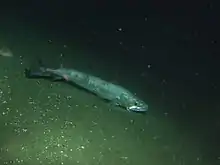| Merluccius | |
|---|---|
 | |
| Merluccius productus | |
| Scientific classification | |
| Domain: | Eukaryota |
| Kingdom: | Animalia |
| Phylum: | Chordata |
| Class: | Actinopterygii |
| Order: | Gadiformes |
| Family: | Merlucciidae |
| Subfamily: | Merlucciinae |
| Genus: | Merluccius Rafinesque, 1810 |
| Type species | |
| Merluccius smiridus Rafinesque, 1810 | |
 | |
| Distribution of American Merluccius spp. | |
| Synonyms[1] | |
Merluccius is a genus of merluccid hakes from the Atlantic and Pacific Oceans, where mainly found relatively deep.
The generic name is derived from French mer ("sea") and Latin lucius, "pike."[2]
Species
The 14 recognized species in this genus are:[3]
- Merluccius albidus (Mitchill, 1818) (offshore silver hake)
- Merluccius angustimanus Garman, 1899 (Panama hake)
- Merluccius australis (F. W. Hutton, 1872) (southern hake) [4]
- Merluccius bilinearis (Mitchill, 1814) (silver hake)
- Merluccius capensis Castelnau, 1861 (shallow-water Cape hake)
- Merluccius gayi (Guichenot, 1848)
- Merluccius hernandezi C. P. Mathews, 1985 (Cortez hake)
- Merluccius hubbsi Marini, 1933 (Argentine hake)
- Merluccius merluccius (Linnaeus, 1758) (European hake)
- Merluccius paradoxus Franca, 1960 (deep-water cape hake)
- Merluccius patagonicus Lloris & Matallanas, 2003 (Patagonian hake)
- Merluccius polli Cadenat, 1950 (Benguela hake)
- Merluccius productus (Ayres, 1855) (North Pacific hake)
- Merluccius senegalensis Cadenat, 1950 (Senegalese hake)
References
- ↑ William Eschmeyer, ed. (2018). "SEARCH RESULTS FROM THE Catalog of Fishes Genera that contain: Merluccius". Catalog of Fishes. California Academy of Sciences. Retrieved 6 April 2018.
- ↑ "Merluccius merluccius, European hake : fisheries". www.fishbase.se.
- ↑ Froese, Rainer and Pauly, Daniel, eds. (2018). Species of Merluccius in FishBase. April 2018 version.
- ↑ Deli Antoni, M.Y., Delpiani, S.M., Stewart, A.L., González-Castro, M. & Díaz De Astarloa, J.M. (2015): Merluccius tasmanicus Matallanas & Lloris 2006 is a junior synonym of M. australis (Hutton 1872) (Gadiformes: Merluciidae) based on morphological and molecular data. Zootaxa, 3956 (1): 29–55.
This article is issued from Wikipedia. The text is licensed under Creative Commons - Attribution - Sharealike. Additional terms may apply for the media files.